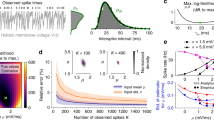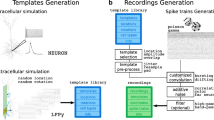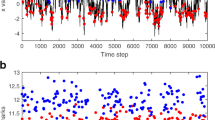Abstract
We developed a general method to generate populations of artificial spike trains (ASTs) that match the statistics of recorded neurons. The method is based on computing a Gaussian local rate function of the recorded spike trains, which results in rate templates from which ASTs are drawn as gamma distributed processes with a refractory period. Multiple instances of spike trains can be sampled from the same rate templates. Importantly, we can manipulate rate-covariances between spike trains by performing simple algorithmic transformations on the rate templates, such as filtering or amplifying specific frequency bands, and adding behavior related rate modulations. The method was examined for accuracy and limitations using surrogate data such as sine wave rate templates, and was then verified for recorded spike trains from cerebellum and cerebral cortex. We found that ASTs generated with this method can closely follow the firing rate and local as well as global spike time variance and power spectrum. The method is primarily intended to generate well-controlled spike train populations as inputs for dynamic clamp studies or biophysically realistic multicompartmental models. Such inputs are essential to study detailed properties of synaptic integration with well-controlled input patterns that mimic the in vivo situation while allowing manipulation of input rate covariances at different time scales.









Similar content being viewed by others
Abbreviations
- aGLR:
-
Adaptive Gaussian Local Rate template
- saGLR:
-
Rate scaled adaptive Local Rate template
- AST:
-
Artificial Spike Train
- CV:
-
Coefficient of Variation
- u:
-
u-fold increase of aGLR rate within single computed ISI (real valued number)
- ISI:
-
Inter-spike Interval
- LV:
-
Local Variation
- MF:
-
Mossy fiber
- MT:
-
Middle temporal area pyramidal neuron
- PC:
-
Purkinje cell
- PETH:
-
Peri Event Time Histogram
- SF:
-
Shift Fraction
- sGLR:
-
Slow Gaussian Local Rate template
References
Abbasi, S., Hudson, A. E., Maran, S. K., Cao, Y., Abbasi, A., Heck, D. H., & Jaeger, D. (2017). Robust transmission of rate coding in the inhibitory Purkinje cell to cerebellar nuclei pathway in awake mice. PLoS Computational Biology, 13.
Abeles, M. (1983). The quantification and graphic display of correlations among three spike trains. IEEE Transactions on Biomedical Engineering, BME-30, 235–239.
Aertsen, A., Diesmann, M., & Gewaltig, M. O. (1996). Propagation of synchronous spiking activity in feedforward neural networks. Journal of Physiology (Paris), 90, 243–247.
Allers, K. A., Ruskin, D. N., Bergstrom, D. A., Freeman, L. E., Ghazi, L. J., Tierney, P. L., & Walters, J. R. (2002). Multisecond periodicities in basal ganglia firing rates correlate with theta bursts in transcortical and hippocampal EEG. J.Neurophysiol., 87, 1118–1122.
Bobier, B., Stewart, T. C., & Eliasmith, C. (2014). A unifying mechanistic model of selective attention in spiking neurons. PLoS Computational Biology, 10.
Brette, R. (2009). Generation of correlated spike trains. Neural Computation, 21, 188–215.
Brown, J., Pan, W. X., & Dudman, J. T. (2014). The inhibitory microcircuit of the substantia nigra provides feedback gain control of the basal ganglia output. Elife, 3, e02397.
Cao, Y., Liu, Y., Jaeger, D., & Heck, D. H. (2017). Cerebellar Purkinje cells generate highly correlated spontaneous slow-rate fluctuations. Frontiers in Neural Circuits, 11, 67.
Cui, Y., Liu, L. D., Khawaja, F. A., Pack, C. C., & Butts, D. A. (2013). Diverse suppressive influences in area MT and selectivity to complex motion features. The Journal of Neuroscience, 33, 16715–16728.
Diesmann, M., Gewaltig, M. O., & Aertsen, A. (1999). Stable propagation of synchronous spiking in cortical neural networks. Nature, 402, 529–533.
Edgerton, J. R., Hanson, J. E., Gunay, C., & Jaeger, D. (2010). Dendritic sodium channels regulate network integration in Globus Pallidus neurons: A modeling study. The Journal of Neuroscience, 30, 15146–15159.
Eliasmith, C., Stewart, T. C., Choo, X., Bekolay, T., DeWolf, T., Tang, Y., & Rasmussen, D. (2012). A large-scale model of the functioning brain. Science, 338, 1202–1205.
Gerstein, G. L., & Perkel, D. H. (1969). Simultaneously recorded trains of action potentials: Analysis and functional interpretation. Science, 164, 828–830.
Gerstein, G. L., & Perkel, D. H. (1972). Mutual temporal relationships among neuronal spike trains statistical techniques for display and analysis. Biophys.J., 12, 453–473.
Grammont, F., & Riehle, A. (1999). Precise spike synchronization in monkey motor cortex involved in preparation for movement. Experimental Brain Research, 128, 118–122.
Gutnisky, D. A., & Josic, K. (2010). Generation of spatiotemporally correlated spike trains and local field potentials using a multivariate autoregressive process. Journal of Neurophysiology, 103, 2912–2930.
Hutcheon, B., & Yarom, Y. (2000). Resonance, oscillation and the intrinsic frequency preferences of neurons. Trends in Neurosciences, 23, 216–222.
Izhikevich, E. M. (2006). Polychronization: Computation with spikes. Neural Computation, 18, 245–282.
Izhikevich, E. M., & Hoppensteadt, F. C. (2009). Polychronous wavefront computations. International Journal of Bifurcation and Chaos, 19, 1733–1739.
Jaeger, D., & Bower, J. M. (1999). Synaptic control of spiking in cerebellar Purkinje cells: Dynamic current clamp based on model conductances. The Journal of Neuroscience, 19, 6090–6101.
Jaeger, D., DeSchutter, E., & Bower, J. M. (1997). The role of synaptic and voltage-gated currents in the control of Purkinje cell spiking: A modeling study. The Journal of Neuroscience, 17, 91–106.
Jun, J. J., Steinmetz, N. A., Siegle, J. H., Denman, D. J., Bauza, M., Barbarits, B., Lee, A. K., Anastassiou, C. A., Andrei, A., Aydin, C., et al. (2017). Fully integrated silicon probes for high-density recording of neural activity. Nature, 551, 232–236.
Krumin, M., & Shoham, S. (2009). Generation of spike trains with controlled auto- and cross-correlation functions. Neural Computation, 21, 1642–1664.
Lang, E. J., Sugihara, I., Welsh, J. P., & Llinas, R. (1999). Patterns of spontaneous Purkinje cell complex spike activity in the awake rat. The Journal of Neuroscience, 19, 2728–2739.
Ledergerber, D., & Larkum, M. E. (2010). Properties of layer 6 pyramidal neuron apical dendrites. The Journal of Neuroscience, 30, 13031–13044.
Lewis, T. J., & Rinzel, J. (2003). Dynamics of spiking neurons connected by both inhibitory and electrical coupling. Journal of Computational Neuroscience, 14, 283–309.
Lin, R. J., & Jaeger, D. (2011). Using computer simulations to determine the limitations of dynamic clamp stimuli applied at the soma in mimicking distributed conductance sources. Journal of Neurophysiology, 105, 2610–2624.
Lyamzin, D. R., Macke, J. H., & Lesica, N. A. (2010). Modeling population spike trains with specified time-varying spike rates, trial-to-trial variability, and pairwise signal and noise correlations. Frontiers in Computational Neuroscience, 4, 144.
Lyamzin, D. R., Barnes, S. J., Donato, R., Garcia-Lazaro, J. A., Keck, T., & Lesica, N. A. (2015). Nonlinear transfer of signal and noise correlations in cortical networks. The Journal of Neuroscience, 35, 8065–8080.
Macke, J. H., Berens, P., Ecker, A. S., Tolias, A. S., & Bethge, M. (2009). Generating spike trains with specified correlation coefficients. Neural Computation, 21, 397–423.
Major, G., Larkum, M. E., & Schiller, J. (2013). Active properties of neocortical pyramidal neuron dendrites. Annual Review of Neuroscience, 36, 1–24.
Marre, O., El Boustani, S., Frégnac, Y., & Destexhe, A. (2009). Prediction of spatiotemporal patterns of neural activity from pairwise correlations. Physical Review Letters, 102.
Mel, B. W. (1993). Synaptic integration in an excitable dendritic tree. Journal of Neurophysiology, 70, 1086–1101.
Miura, K., Okada, M., & Amari, S. I. (2006). Estimating spiking irregularities under changing environments. Neural Computation, 18, 2359–2386.
Murphy, B. K., & Miller, K. D. (2003). Multiplicative gain changes are induced by excitation or inhibition alone. The Journal of Neuroscience, 23, 10040–10051.
Murphy, P. R., O'Connell, R. G., O'Sullivan, M., Robertson, I. H., & Balsters, J. H. (2014). Pupil diameter Covaries with BOLD activity in human locus Coeruleus. Human Brain Mapping, 35, 4140–4154.
Niebur, E. (2007). Generation of synthetic spike trains with defined pairwise correlations. Neural Computation, 19, 1720–1738.
Ozden, I., Sullivan, M. R., Lee, H. M., & Wang, S. S. H. (2009). Reliable coding emerges from Coactivation of climbing fibers in microbands of cerebellar Purkinje neurons. The Journal of Neuroscience, 29, 10463–10473.
Paulin, M. G., & Hoffman, L. F. (2001). Optimal firing rate estimation. Neural Networks, 14, 877–881.
Pillow, J. W., Shlens, J., Paninski, L., Sher, A., Litke, A. M., Chichilnisky, E. J., & Simoncelli, E. P. (2008). Spatio-temporal correlations and visual signalling in a complete neuronal population. Nature, 454, 995–999.
Pipa, G., Grün, S., & van Vreeswijk, C. (2013). Impact of spike train autostructure on probability distribution of joint spike events. Neural Computation, 25, 1123–1163.
Pisauro, M. A., Benucci, A., & Carandini, M. (2016). Local and global contributions to hemodynamic activity in mouse cortex. Journal of Neurophysiology, 115, 2931–2936.
Poirazi, P., Brannon, T., & Mel, B. W. (2003). Arithmetic of subthreshold synaptic summation in a model CA1 pyramidal cell. Neuron, 37, 977–987.
Polsky, A., Mel, B., & Schiller, J. (2009). Encoding and decoding bursts by NMDA spikes in basal dendrites of layer 5 pyramidal neurons. The Journal of Neuroscience, 29, 11891–11903.
Prinz, A. A., Bucher, D., & Marder, E. (2004). Similar network activity from disparate circuit parameters. Nature Neuroscience, 7, 1345–1352.
Reimer, J., McGinley, M. J., Liu, Y., Rodenkirch, C., Wang, Q., McCormick, D. A., & Tolias, A. S. (2016). Pupil fluctuations track rapid changes in adrenergic and cholinergic activity in cortex. Nature Communications, 7, 13289.
Robinson, H. P. C., & Kawai, N. (1993). Injection of digitally synthesized synaptic conductance transients to measure the integrative properties of neurons. Journal of Neuroscience Methods, 49, 157–165.
Ruskin, D. N., Bergstrom, D. A., Kaneoke, Y., Patel, B. N., Twery, M. J., & Walters, J. R. (1999a). Multisecond oscillations in firing rate in the basal ganglia: Robust modulation by dopamine receptor activation and anesthesia. Journal of Neurophysiology, 81, 2046–2055.
Ruskin, D. N., Bergstrom, D. A., & Walters, J. R. (1999b). Multisecond oscillations in firing rate in the globus pallidus: Synergistic modulation by D1 and D2 dopamine receptors. The Journal of Pharmacology and Experimental Therapeutics, 290, 1493–1501.
Ruskin, D. N., Bergstrom, D. A., Tierney, P. L., & Walters, J. R. (2003). Correlated multisecond oscillations in firing rate in the basal ganglia: Modulation by dopamine and the subthalamic nucleus. Neuroscience, 117, 427–438.
Schneider, M., Hathway, P., Leuchs, L., Samann, P. G., Czisch, M., & Spoormaker, V. I. (2016). Spontaneous pupil dilations during the resting state are associated with activation of the salience network. Neuroimage, 139, 189–201.
Sharp, A. A., Oneil, M. B., Abbott, L. F., & Marder, E. (1993). Dynamic clamp - computer-generated Conductances in real neurons. Journal of Neurophysiology, 69, 992–995.
Shimaoka, D., Harris, K. D., & Carandini, M. (2018). Effects of arousal on mouse sensory cortex depend on modality. Cell Reports, 22, 3160–3167.
Shimaoka, D., Steinmetz, N. A., Harris, K. D., & Carandini, M. (2019). The impact of bilateral ongoing activity on evoked responses in mouse cortex. Elife, 8.
Shinomoto, S., Shima, K., & Tanji, J. (2003). Differences in spiking patterns among cortical neurons. Neural Computation, 15, 2823–2842.
Shinomoto, S., Miura, K., & Koyama, S. (2005). A measure of local variation of inter-spike intervals. Biosystems, 79, 67–72.
Silver, R. A. (2010). Neuronal arithmetic. Nature Reviews Neuroscience, 11, 474–489.
Steuber, V., Schultheiss, N. W., Silver, R. A., De Schutter, E., & Jaeger, D. (2011). Determinants of synaptic integration and heterogeneity in rebound firing explored with data driven models of deep cerebellar nucleus cells. Journal of Computational Neuroscience, 30, 633–658.
Stewart, T. C., Bekolay, T., & Eliasmith, C. (2012). Learning to select actions with spiking neurons in the basal ganglia. Frontiers in Neuroscience, 6, 2.
Stringer, C., Pachitariu, M., Steinmetz, N., Bai Reddy, C., Carandini, M., & Harris, K. D. (2018). Spontaneous behaviors drive multidimensional, brain-wide population activity. bioRxiv.
Stringer, C., Pachitariu, M., Steinmetz, N., Reddy, C. B., Carandini, M., & Harris, K. D. (2019). Spontaneous behaviors drive multidimensional, brainwide activity. Science, 364, 255.
Traub, R. D., Kopell, N., Bibbig, A., Buhl, E. H., LeBeau, F. E., & Whittington, M. A. (2001). Gap junctions between interneuron dendrites can enhance synchrony of gamma oscillations in distributed networks. The Journal of Neuroscience, 21, 9478–9486.
Wagner, H., Takahashi, T., & Konishi, M. (1987). Representation of interaural time difference in the central nucleus of the barn owl's inferior colliculus. J.Neurosci., 7, 3105–3116.
Wagner, M. J., Kim, T. H., Kadmon, J., Nguyen, N. D., Ganguli, S., Schnitzer, M. J., & Luo, L. (2019). Shared cortex-cerebellum dynamics in the execution and learning of a motor task. Cell., 177, 669–682. e24.
Welsh, J. P., Lang, E. J., Suglhara, I., & Llinas, R. (1995). Dynamic organization of motor control within the olivocerebellar system. Nature, 374, 453–457.
Yellin, D., Berkovich-Ohana, A., & Malach, R. (2015). Coupling between pupil fluctuations and resting-state fMRI uncovers a slow build-up of antagonistic responses in the human cortex. Neuroimage, 106, 414–427.
Acknowledgements
This work was supported in part by NIH grant R01NS067201 to D.Jaeger. The content is solely the responsibility of the authors and does not necessarily represent the official views of the National Institutes of Health. Cerebellar data were recorded in the Heck lab at UTHS.
Author information
Authors and Affiliations
Corresponding author
Ethics declarations
Conflict of interest
The authors declare that they have no conflict of interest.
Additional information
Action Editor: Alain Destexhe
Publisher’s note
Springer Nature remains neutral with regard to jurisdictional claims in published maps and institutional affiliations.
Rights and permissions
About this article
Cite this article
Abbasi, S., Maran, S. & Jaeger, D. A general method to generate artificial spike train populations matching recorded neurons. J Comput Neurosci 48, 47–63 (2020). https://doi.org/10.1007/s10827-020-00741-w
Received:
Revised:
Accepted:
Published:
Issue Date:
DOI: https://doi.org/10.1007/s10827-020-00741-w




